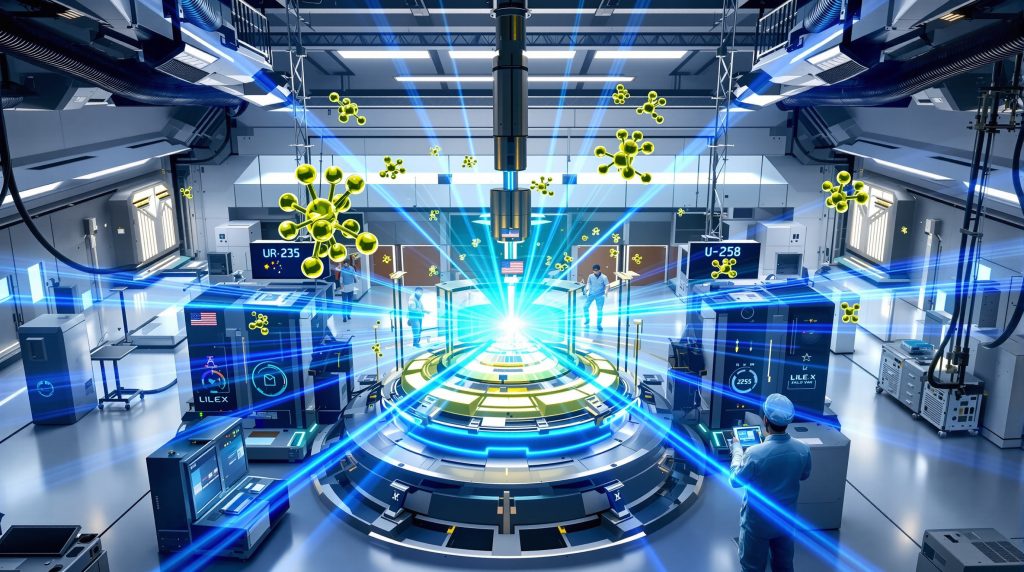Laser Enrichment Breakthrough: Revolutionizing Nuclear Fuel Production
The landscape of nuclear fuel production is undergoing a remarkable transformation with the recent successful demonstration of laser uranium enrichment technology. This innovative approach, which uses precisely calibrated lasers to separate uranium isotopes, represents a significant advancement beyond traditional centrifuge methods and could fundamentally reshape how nuclear fuel is produced worldwide.
Understanding Laser Enrichment Technology
Laser enrichment technology represents a fundamental shift in how we process uranium. Unlike conventional centrifuge methods that rely on mass differences between isotopes, laser-based systems exploit subtle differences in the atomic properties of uranium isotopes. The technology uses specialized lasers calibrated to specific wavelengths that selectively target uranium-235 atoms, separating them from the more abundant uranium-238 with unprecedented precision.
This innovative approach offers several key advantages over traditional methods:
- Potentially greater energy efficiency with lower power consumption
- Smaller physical footprint for processing facilities
- More precise targeting of specific isotopes
- Reduced environmental impact through streamlined processing
The SILEX (Separation of Isotopes by Laser Excitation) process at the heart of this breakthrough uses light to differentiate between isotopes based on their unique quantum properties rather than relying solely on physical characteristics like mass. This quantum-based approach allows for a level of selectivity impossible with mechanical separation methods.
How GLE Achieved This Technological Milestone
The recent large-scale testing campaign at Global Laser Enrichment's (GLE) Test Loop facility in Wilmington, North Carolina marks the culmination of years of research and development. Beginning in May 2025, this demonstration has successfully validated the commercial viability of the SILEX laser enrichment process.
The Wilmington Test Loop Demonstration
The demonstration program has already produced hundreds of kilograms of low-enriched uranium and will continue through the end of 2025. According to official statements from GLE, the extensive performance data collected provides strong confidence that the process can be successfully deployed at commercial scale.
Key achievements from the demonstration include:
- Production of significant quantities of enriched uranium using laser technology
- Collection of comprehensive performance data validating commercial potential
- Demonstration of process reliability under continuous operation
- Validation of key engineering systems and controls
This testing represents a critical Technology Readiness milestone, indicating the technology has been successfully demonstrated in a relevant environment that simulates operational conditions. The achievement comes after years of laboratory testing, engineering refinements, and system optimization.
Technical Evolution
The path to this breakthrough has involved significant technical innovation, including:
- Development of specialized laser systems with precise wavelength control
- Creation of unique materials capable of withstanding the enrichment environment
- Engineering of sophisticated control systems for process management
- Design of specialized containment and handling systems for nuclear materials
Strategic Implications for U.S. Nuclear Energy
The successful demonstration of laser enrichment technology carries profound implications for America's energy security and nuclear capabilities.
Addressing Critical Supply Chain Vulnerabilities
With nuclear power providing approximately 20% of U.S. electricity, securing the fuel supply chain represents a strategic priority. Currently, the United States relies heavily on foreign-owned enrichment capacity, creating potential US uranium market risks in the nuclear fuel cycle.
GLE CEO Stephen Long has emphasized that this breakthrough will "allow America to end its dangerous dependency on a fragile, foreign government-owned uranium fuel supply chain." The development of domestic enrichment capability using laser technology offers several strategic advantages:
- Reduced reliance on international suppliers for critical nuclear fuel
- Enhanced energy security through domestic production capabilities
- Development of a resilient nuclear fuel ecosystem within U.S. borders
- Support for the continued operation of America's existing nuclear fleet
Enabling Advanced Reactor Deployment
Beyond conventional nuclear fuel, laser enrichment technology could play a crucial role in producing the high-assay low-enriched uranium (HALEU) required for many advanced reactor designs. This specialized fuel, which contains uranium enriched between 5% and 20% U-235, is essential for smaller, more efficient reactor designs currently under development.
The ability to produce HALEU domestically would:
- Accelerate deployment of next-generation nuclear technologies
- Support U.S. leadership in advanced nuclear innovation
- Enable smaller, safer reactor designs with enhanced efficiency
- Provide fuel options for small modular reactors (SMRs) and microreactors
The Paducah Laser Enrichment Facility (PLEF)
The demonstration program represents a stepping stone toward full commercial implementation at the planned Paducah Laser Enrichment Facility in Kentucky.
Project Scope and Timeline
GLE has completed submission of a comprehensive application to the U.S. Nuclear Regulatory Commission for the PLEF, which will deploy the SILEX technology at commercial scale. This facility represents an innovative approach to uranium resource utilization by focusing on re-enrichment of depleted uranium tails from legacy Department of Energy operations.
The PLEF project features:
- Plans to process approximately 200,000 tonnes from the Department of Energy's depleted uranium hexafluoride inventory
- Projected production capacity of up to 6 million separative work units of LEU annually
- Integration of uranium processing, conversion, and enrichment capabilities at a single site
- A long-term agreement with the Department of Energy signed in 2016 that underpins the project
While the exact timeline for commercial operations remains subject to regulatory approvals, industry analysts project that the facility could begin operations around 2030, with potential for acceleration based on the successful demonstration results.
Value Proposition and Environmental Benefits
The PLEF project offers a compelling combination of economic and environmental advantages by repurposing existing uranium stockpiles:
- Extraction of remaining energy value from previously underutilized resources
- Reduction of waste storage requirements for legacy materials
- Creation of valuable nuclear fuel from material previously considered waste
- Development of domestic manufacturing and supply chain capabilities
By converting depleted uranium tails into usable fuel, the project effectively transforms a storage liability into a strategic energy asset while reducing the overall environmental footprint of the nuclear fuel cycle.
Key Players in Technology Development
The development of laser enrichment technology involves a strategic partnership between industry leaders with complementary expertise.
The GLE Joint Venture Structure
Global Laser Enrichment represents a collaboration between:
- Silex Systems (51% ownership) – An Australian technology developer and inventor of the SILEX process
- Cameco Corporation (49% ownership) – A major uranium producer with extensive fuel cycle experience
This partnership combines Silex's breakthrough technology with Cameco's deep experience in uranium processing and nuclear fuel production. As the exclusive global licensee of the SILEX technology, GLE has integrated the scientific innovation with practical industrial implementation capabilities.
Public-Private Collaboration
The advancement of laser enrichment technology has benefited from strategic cooperation between industry and government entities:
- Long-term agreement with the Department of Energy for depleted uranium feedstock
- Regulatory engagement with the Nuclear Regulatory Commission
- Alignment with national energy security objectives
- Development of domestic manufacturing capabilities
This collaborative approach has enabled the technology to progress from laboratory concept to commercial-scale demonstration while addressing the complex regulatory and security considerations inherent in nuclear technology development.
Challenges for Commercial Implementation
While the successful demonstration represents significant progress, several challenges remain on the path to full commercial implementation.
Regulatory and Licensing Process
The nuclear industry operates within a comprehensive regulatory framework designed to ensure safety, security, and nonproliferation. Key regulatory milestones for the PLEF include:
- Completion of the NRC review process for the license application
- Environmental impact assessments and public consultation periods
- Safety and security certifications for commercial operations
- Implementation of international safeguards and monitoring systems
These regulatory processes are designed to be thorough and may require several years to complete, though the successful demonstration provides valuable data to support the licensing process.
Technical and Operational Scaling
Moving from demonstration to full commercial operation involves addressing several technical challenges:
- Scaling production capacity to commercial levels
- Establishing robust manufacturing capabilities for specialized components
- Developing the skilled workforce needed for operations
- Implementing comprehensive quality control systems for nuclear-grade materials
The demonstration program's continued operation through 2025 will provide additional operational experience and data to address these scaling challenges.
Impact on Global Nuclear Markets
The successful commercialization of laser enrichment technology could significantly influence global nuclear fuel markets and international energy dynamics.
Market Transformation Potential
The introduction of a new enrichment technology alongside existing centrifuge methods may create several market effects:
- Potential efficiency advantages that could influence long-term uranium price dynamics
- Diversification of enrichment technology options and suppliers
- Creation of new value streams from depleted uranium stockpiles
- Evolution of the competitive landscape among fuel suppliers
While the exact market impact remains to be determined, the technology offers the potential to create new supply options in a market historically dominated by a small number of providers using centrifuge technology.
International Positioning
The advancement of laser enrichment technology has implications for international nuclear cooperation and competitiveness:
- Positioning of U.S.-based technology in global markets
- Potential for appropriate technology transfer under international safeguards
- Competitive response from established enrichment providers
- Opportunities for international partnerships in deployment
The technology's development also reinforces the importance of maintaining strong nonproliferation frameworks while enabling peaceful nuclear applications.
Long-Term Implications for Nuclear Energy
Beyond its immediate applications in uranium enrichment, the successful demonstration of laser technology has broader implications for nuclear energy's role in the clean energy transition.
Supporting Nuclear Power's Clean Energy Contribution
The development of advanced enrichment capabilities strengthens nuclear energy's position as a reliable clean energy source:
- Ensuring fuel availability for existing and future reactors
- Enabling lifecycle extensions for the current nuclear fleet
- Supporting deployment of advanced nuclear technologies
- Reinforcing nuclear's role as a stable, carbon-free baseload power source
With growing recognition of nuclear power's importance in addressing climate challenges, secure fuel supply chains become increasingly strategic for energy planning.
Innovation Ecosystem Development
The laser enrichment technology development process demonstrates the power of sustained innovation and creates broader benefits:
- Advancement of precision laser applications beyond nuclear technology
- Development of specialized materials and manufacturing processes
- Training of highly skilled technical workforce
- Establishment of successful commercialization pathways for complex technologies
These innovation spillovers extend the impact of the technology beyond its direct application in uranium enrichment.
FAQ: Laser Enrichment Technology
How does laser enrichment differ from centrifuge enrichment?
Laser enrichment uses precisely tuned lasers to selectively excite and separate uranium-235 atoms based on their quantum properties. This contrasts with centrifuge technology, which relies on the small mass difference between isotopes and mechanical spinning to achieve separation. The laser approach offers potential advantages in efficiency, energy consumption, and facility footprint.
What enrichment levels can the SILEX process achieve?
The SILEX process is highly flexible and can potentially produce various enrichment levels, from natural uranium equivalent (approximately 0.7% U-235) to low-enriched uranium (up to 5% U-235) for conventional reactors. With appropriate licensing and safeguards, the technology could also produce high-assay low-enriched uranium (HALEU) with enrichment levels between 5% and 20% for advanced reactor designs.
What safeguards are in place for this sensitive technology?
Laser enrichment technology is subject to rigorous international and domestic safeguards to prevent proliferation risks. These include comprehensive NRC licensing requirements, International Atomic Energy Agency (IAEA) monitoring and inspections, physical security measures at facilities, export controls on sensitive components and technology, and continuous monitoring and accounting of nuclear materials.
When might commercial laser enrichment begin operation?
Based on current projections, the Paducah Laser Enrichment Facility could begin commercial operations around 2030, with potential for acceleration depending on regulatory approvals and construction timelines. The successful technology demonstration represents a significant step toward this timeline.
A Transformative Advancement in Nuclear Fuel Production
The successful demonstration of laser enrichment technology represents a pivotal advancement in nuclear fuel cycle capabilities. By validating the commercial viability of this innovative approach, GLE has established a pathway toward enhanced domestic uranium enrichment capacity with far-reaching implications for energy security, advanced nuclear deployment, and sustainable fuel production.
As the technology progresses toward full commercialization at the planned Paducah facility, it offers the potential to transform underutilized depleted uranium stockpiles into valuable fuel resources while strengthening America's position in the global nuclear industry. This development aligns with broader goals of energy independence, technological leadership, and clean energy production.
The laser enrichment breakthrough exemplifies how targeted innovation can address strategic challenges while creating new opportunities in the nuclear sector. As the demonstration program continues through 2025, it will further validate the technology's readiness for commercial deployment and its potential to reshape nuclear fuel production for decades to come, even as the industry faces ongoing challenges related to uranium market volatility and uranium mining halt in some regions. Furthermore, advancements in nuclear waste disposal innovations will complement these enrichment technologies in creating a more sustainable nuclear fuel cycle.
Looking for the Next Major Uranium Investment Opportunity?
Stay ahead of transformative developments in nuclear fuel technology with Discovery Alert's proprietary Discovery IQ model, which provides instant notifications on significant ASX uranium discoveries and emerging opportunities. Explore why major mineral discoveries can lead to substantial returns by visiting Discovery Alert's dedicated discoveries page and position yourself to capitalise on the next uranium breakthrough.




